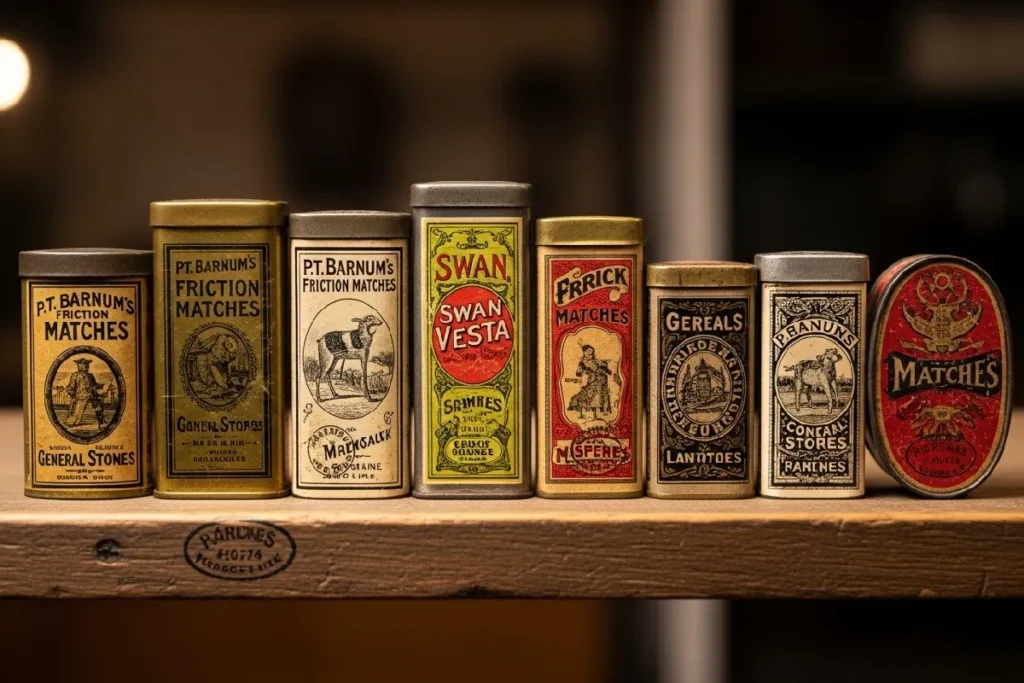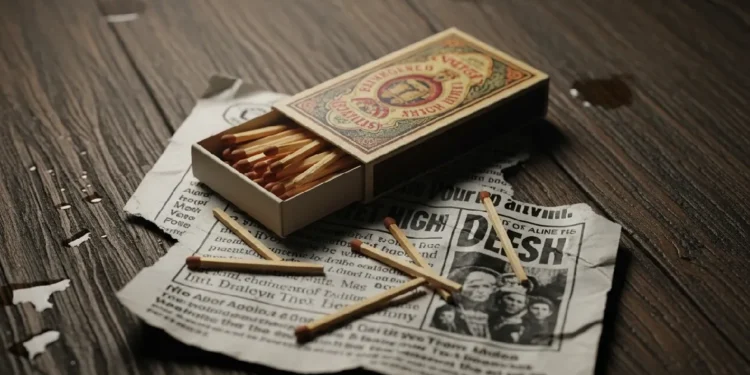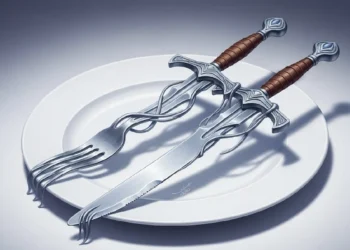A close look at the history of the match — how a tiny flame became a tool of everyday convenience, clandestine resistance, ritual practice, and industrial catastrophe.
Table of Contents
Introduction
The history of the match begins not with a clean spark of genius, but with poison, fire, and bone. We hold this object in our hands—a mere sliver of wood tipped with a chemical compound—and see only its function. It is a tool of convenience, a fleeting burst of light to ignite a candle or a campfire before being crushed underfoot or tossed aside, its brief purpose served. We treat it as disposable, simple, and silent. But its silence is a lie. The unassuming matchstick is, in fact, one of the most politically charged and socially significant artifacts of the modern era, a miniature monument to both human ingenuity and our capacity for industrial cruelty.
This sanitized perception is a dangerous fiction, allowing us to ignore the brutal realities embedded in the everyday objects we use. The convenience we take for granted was bought with the disfigured bodies of exploited workers. Its simple form belies a complex role as a medium for propaganda, a tool for spies, and a symbol for protestors. To understand the complete history of the match is to confront a story of power: who wields it, who suffers for it, and how even the smallest of objects can be used to resist it. It is a story of how a tamed flame became an untamable force for social change.
This article dismantles the myth of the simple match. We will journey back to its volatile and hazardous chemical origins, then descend into the industrial hellscape of the 19th-century factory, where the “phossy jaw” epidemic gave rise to the landmark Matchgirls’ Strike. From there, we will explore the matchbox as a cultural canvas and the act of striking a match as a private ritual. We will uncover its dual life as a tool for both clandestine rebellion and public protest, before finally examining its enduring legacy in our digital age. This is the story of a tiny stick that ignited a revolution.
The Unstable Spark: Charting the Origin of Friction Matches
The sanitized story of invention—a lone genius in a lab coat having a sudden, clean breakthrough—is a fiction that ill-serves the chaotic and dangerous early history of the match. Before a reliable flame could fit in your pocket, there was a desperate, almost primal, hunger for on-demand fire. This need spawned a series of hazardous contraptions, from phosphorus-tipped splints sealed in glass vials that had to be broken to ignite, to the ostentatious “prometheans” that burst into flame when crushed with pliers to release a drop of sulfuric acid. These were not tools of convenience but of risk, early attempts to tame a chemical reaction that was still poorly understood and violently unpredictable.
It was within this context of volatile experimentation that English chemist John Walker made his accidental discovery in 1826. While stirring a pot of chemicals, he noticed a dried glob had formed on the end of his mixing stick. On an impulse, he scraped it against his stone hearth, and it flared to life. These first friction matches, which he called “Congreves,” were a crucial step forward, but they were smelly, inconsistent, and prone to showering the user with sparks. The complete history of the match didn’t begin with a single, perfect invention, but with a clumsy, fumbling step towards controlling a powerful force.
The truly explosive chapter in the history of the match began not with Walker’s safer formula, but with the adoption of its far more volatile cousin: white phosphorus. This was the innovation that made the match a commercial juggernaut. A white phosphorus match would ignite on nearly any rough surface, offering a seductive and unprecedented level of convenience. But this technological leap was a deal with the devil. The ingredient that made the flame so easy to summon would go on to poison the bodies of the workers who made them, marking a flawed history of the match where progress was measured in profit at the direct expense of human life.

The Poisoned Flame: Industrial Catastrophe and the Match Industry Evolution
The dazzling commercial success of the white phosphorus match was a toxic bargain, paid for by the lives of its makers. Inside the sprawling factories of the late 19th century, the air hung thick with poisonous fumes that settled into the bones of the workers, who were predominantly young women and children. Every match struck for convenience in a Victorian home was a product of a system that treated human beings as disposable components. This grim reality is an inescapable and defining feature of the match industry’s evolution, a period where the demand for a cheap, portable flame directly fueled a public health catastrophe.
This catastrophe had a name: phosphorus necrosis, or “phossy jaw.” It was a horrific industrial disease that began with excruciating toothaches and led to festering abscesses that decayed the jawbone. In the dark, the afflicted workers’ jaws would emit an eerie, greenish-white glow. The condition led to grotesque facial disfigurement, brain damage, and, ultimately, a slow and agonizing death. This suffering was not an accident but a direct consequence of the flawed history of the match’s production—a process that prioritized profit over the most basic elements of phosphorus safety history.
But from this immense suffering came an equally immense act of defiance. In 1888, the women and teenage girls working at the Bryant & May factory in London walked out, protesting their slave-like wages and the deadly conditions that were killing them. The Matchgirls’ Strike, championed by activist Annie Besant, captured public attention and generated an outcry that the factory owners could not ignore. Their victory was a landmark moment, not just in labor rights, but in the history of the match itself. It forced a global conversation that would eventually lead to the banning of white phosphorus and the adoption of safer alternatives, proving that even the most oppressed could use their collective voice to change the world.
A Pocketful of Power: The Matchbox Cultural History and Everyday Ritual
Once the industrial horrors began to recede with the advent of the safety match, the object itself settled into a new role: an intimate companion in daily life. The transition from a dangerous novelty to a ubiquitous household tool marked a profound shift in the history of the match. This tiny, tamed flame was no longer just a marvel of chemistry but a fixture of the kitchen, the smoker’s pocket, and the camper’s pack. It represented a newfound mastery over one of humanity’s oldest needs, democratizing fire and placing a pocket-sized spark of potential into the hands of ordinary people, fundamentally changing how we interacted with light and heat.
This domestication gave rise to a fascinating and often overlooked medium: the matchbox itself. The matchbox cultural history reveals that these small cardboard containers became miniature billboards and canvases, among the earliest forms of mass-produced graphic media. Hotels and restaurants used them for branding, governments used them for propaganda, and artists used them to showcase stunning designs. From Japanese ukiyo-e prints to bold Soviet-era graphics, the matchbox was a vehicle for communicating identity, ideology, and commerce to a vast audience, turning a disposable item into a powerful cultural artifact.
Beyond its physical container, the act of striking a match became imbued with ritualistic significance. It is a multisensory event: the sharp, percussive scrape, the hiss of the chemical ignition, the pungent curl of sulfur, and the sudden bloom of light. Film and literature seized on this potent symbolism. A lit match can represent a sudden flash of inspiration, a moment of quiet contemplation before a difficult decision, or the tense prelude to an explosion. This sensory weight ensures that even in an age of disposable lighters, the deliberate act of striking a match retains a unique power, a tangible connection to the more dramatic side of the history of the match.

The Arsonist’s Tool and the Activist’s Spark: Matches and Civil Unrest
The same accessibility that made the match a household staple also made it a potent weapon. In the hands of an arsonist, a saboteur, or a rebel, a single matchstick holds the power to erase a building, destroy a harvest, or send a terrifying message of dissent. This duality—the ability to both create a warming hearth and unleash a destructive inferno—is central to the political history of the match. Its simplicity and disposability make it a democratic tool for disruption. It requires no special training or great expense to wield, placing the power of chaos within anyone’s grasp and complicating the narrative of its benevolent progress.
This darker utility was not lost on those operating in the shadows. Throughout the 20th century, the unassuming matchbook became a standard piece of spycraft equipment. Intelligence agents and resistance fighters used them to pass secret messages, conceal microfilm, or signal contacts. The mundane nature of the object made it the perfect cover, an item no one would look at twice. This covert role in wartime and espionage adds a thrilling and clandestine chapter to the history of the match, transforming it from a simple fire-starter into an instrument of intrigue and rebellion against oppressive regimes.
More powerful than its use in actual arson, however, is the match’s symbolic role in protest. The image of a single flame held against the darkness is a universal metaphor for hope, defiance, and the start of a revolution. It represents the potential for one small, seemingly insignificant act to ignite a massive movement for change. When activists light candles or torches at a vigil, they are drawing on this deep-seated symbolism. This act forces us into rethinking the history of the match, seeing it not just as an object but as an enduring icon of political will and the enduring belief that one lone spark can, and will, overcome the dark.
The Enduring Flame: Rethinking the History of the Match in a Digital Age
In an era of push-button ignition and disposable butane lighters, the humble match can feel like a relic, a charming anachronism from a bygone time. Its reign as the undisputed king of portable fire is long over. Yet, to declare it obsolete is to miss the final, fascinating chapter in the history of the match. Its retreat from mass utility has not been an end but a transformation. The consequences of the history of the match show us that when an object sheds its primary function, it often gains a new, more deliberate kind of power. Its story is far from finished.
Today, the match thrives in niches where experience trumps convenience. It has become a boutique object, a small luxury. We see it alongside expensive scented candles, where its sulfurous flare is part of the sensory ritual. It’s the preferred tool for lighting a fine cigar, as it imparts no chemical taste. And it remains a gold-standard item in survival kits, a reliable, non-mechanical flame that works in conditions where a lighter might fail. In each case, choosing a match is an intentional act—a rejection of sterile efficiency in favor of a more tactile, primal, and satisfying connection to fire.
Ultimately, the long, fraught, and often violent history of the match serves as a powerful reminder. It teaches us that no object is ever just an object. Behind the most mundane tools are stories of human ingenuity, brutal exploitation, courageous rebellion, and profound cultural meaning. Rethinking the history of the match compels us to look closer at the world we’ve built, to question the hidden costs of our conveniences, and to find the extraordinary narratives of power and protest that are embedded in the overlooked corners of our everyday lives.

Conclusion
We’ve peeled back the facade of the disposable match to reveal a complex and often brutal history. What seems like a simple tool for convenience was, for decades, a product of human agony. The early history of the match is fundamentally tied to the industrial horrors of “phossy jaw,” a painful reminder that the democratization of fire came at the price of worker suffering. Yet, this darkness also sparked fierce rebellion, as the Matchgirls’ Strike of 1888 proved that even the most exploited could ignite a justice movement, fundamentally altering the match industry.
The match transitioned from a dangerous industrial commodity to a potent cultural artifact. The matchbox cultural history reflects its surprising role as a canvas for art and propaganda, while the act of striking a match became a powerful ritual in our daily lives. Beyond the aesthetic, the match has been a political instrument, employed in clandestine operations and civil unrest, from the sabotage of the resistance to the symbolic protests of activists. It is a dual-natured object, capable of both light and destruction, demonstrating that even a common item can hold profound political power.
While lighters and digital tools have replaced the match’s utility, its legacy endures in its current role as a deliberate, ritualistic object. But its true significance lies in its capacity to teach us about the complex relationship between technology, power, and culture. The complete history of the match forces us to confront the hidden political roles of everyday objects. We must rethink the history of the match not as a simple timeline of invention, but as a dynamic narrative of rebellion, risk, and ritual—a testament to the surprising political and cultural roles embedded in the things we so often overlook.








